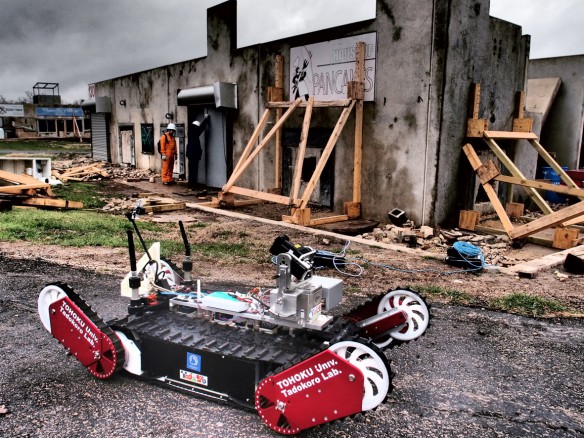2015.03.10
EVENT | March 15, 2015 | Social Implementation of Disaster Robots and Systems – Current State, Gap and Action Plans for the Future

This symposium introduces the current state of disaster robots and the gap to their social implementation by the world top-runners, and discusses the action plans to be taken for the future disaster mitigation.
Robotics is becoming a powerful tool for disaster mitigation, response and recovery after its history of 50 years. For example, unmanned aerial vehicles quickly surveyed wide disaster areas, remotely-operated underwater vehicles repaired leakage of subsea oil plants, and unmanned ground vehicles worked in contaminated areas of damaged nuclear power plants.
The contribution of robotics is mainly 1) for performing tasks that human and conventional tools cannot (e.g. those at inaccessible places and in contaminated areas), 2) for reducing risks (e.g. those of potential explosion, toxic agents and radiation), and/or 3) for reducing time and cost (e.g. quick surveillance of potentially damaged facilities at high places without scaffolds).
The recent evolution of robotics and component technologies is rapidly enhancing their applicable areas and tasks. Remote robotic systems, for example, could gather information from sky 20 years ago. At present, they can approach to structures of interest in the neighborhood for detailed visual inspection from sky, and can enter damaged buildings through narrow entrance for searching victims. Autonomy and robot intelligence reduce responders' load, and integrate gathered information with measured 3D maps. For this reason, specialists predict that robotics would become an essential tool of disaster mitigation, response and recovery in ten years.
For more information:
Recent Articles
-
2015.09.04
EVENT | September 7, 2015 | Think Globally, Act Locally – commemorative event -
2015.03.25
NEWS | Ban Ki-moon Addresses Tohoku University Symposium -
2015.03.12
EVENT | March 15, 2015 | Lessons learned from the Great East Japan Earthquake -
2015.03.10
EXHIBITION | March 14 – 18, 2015 | Tsunami forecasting technology based on real-time geodetic observation -
2015.03.10
EVENT | March 15, 2015 | Social Implementation of Disaster Robots and Systems – Current State, Gap and Action Plans for the Future















































































































